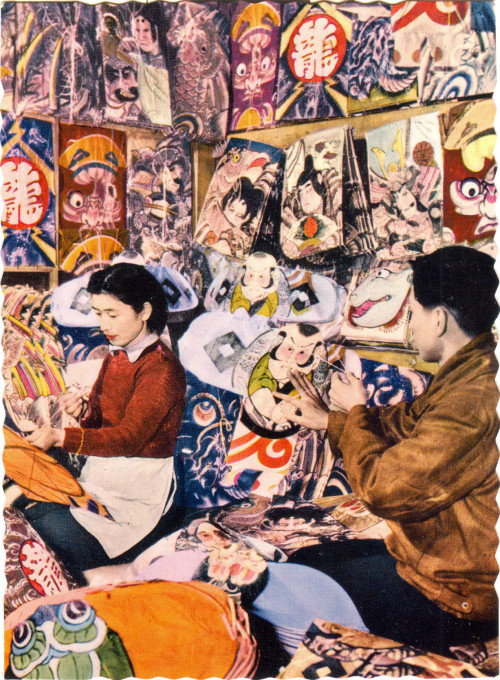
Japanese kite makers, c. 1960. For many centuries, kites were flown in Japan as rites that would ensure benevolent weather and plentiful crops. Nowadays, kits (~dako or ~tako) are flown to celebrate different events: the Emperor’s birthday, the birth of a firstborn son, or Children’s Day.
See also:
Kite-flying culture, c. 1910-1930.
Round kite (wanwan-dako) flying at Naruto, Shikoku, c. 1935.
“It is thought that kites were first introduced into Japan by Buddhist missionaries who arrived from China in the Nara period (649-794 CE) and were first used in religious and thanks-giving ceremonies. A Japanese dictionary dated 981 CE records the use of the Japanese word for kite (kami tobi, paper hawk) – which suggests that the first kites were bird shaped. Kites were also used for practical purposes from earliest times, such as the construction of shrines and temples where large kites were used to lift tiles and other materials up to workers on the scaffolding and roof tops.
“It was in the Edo period (1603-1867), when Japan was closed to all foreigners, that most of the beautiful Japanese kites we know today were developed. There are about 130 different styles and types of kites, each region having its own unique shape. Kites are usually decorated with characters from Japanese folklore, mythology or have some religious or symbolic meaning.
“The popular name for kites now are tako or dako. The Japanese even have a word in their vocabulary ‘tako-kichi’ which means ‘kite crazy’. Traditionally kites are flown on Children’s Day (May 5th), at religious festivals, on public holidays, and at New Year festivities.
“Kites are also flown at harvest festivals, with stalks of rice attached as a symbolic offering of thanks for a good crop. One of the most famous kite festivals is at Hamamatsu where kite teams battle against each other with over 2,000,000 spectators in attendance.
“Hashimoto Tiezo was one of the most famous and last professional kite-makers in Tokyo. He was made a living National Treasure for his work in the traditional arts. Hashimoto died in 1993 but is honored in the Tokyo Kite Museum, located in Ginza’s Taimeiken Restaurant building.”
– Wikipedia

